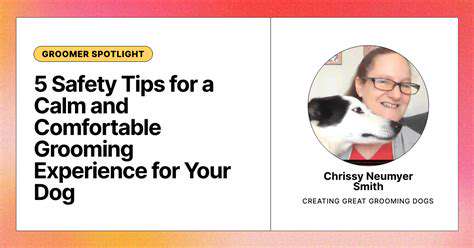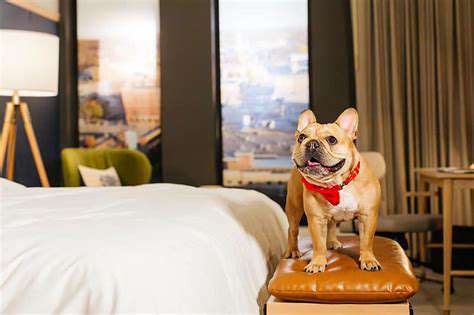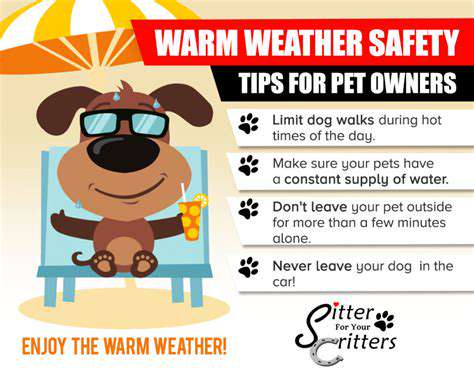Opening Your Own Pet Grooming Salon: What You Need
Understanding Your Target Market
Identifying your ideal pet grooming clientele is crucial for success. Conducting thorough market research involves more than just glancing at local demographics. You need to dig deeper into the types of pets people own in your community, their income brackets, and even their grooming preferences. For instance, certain neighborhoods might have a higher concentration of poodle owners who require regular coat maintenance, while others may have more senior pet owners looking for gentle handling.
Busy professionals often prioritize convenience, so offering flexible scheduling or mobile grooming services could give you an edge. Meanwhile, luxury-focused clients might appreciate add-ons like blueberry facials or pawdicures. Recognizing these subtle differences allows you to craft personalized services that resonate with each segment.
Defining Your Niche
The pet grooming industry is crowded, but specialization can make you stand out. Instead of being a jack-of-all-trades, consider focusing on a specific area like show-quality breed trims, anxiety-reducing grooming for nervous pets, or even creative dye jobs for adventurous owners.
What sets your heart racing when you groom? Maybe you have a knack for perfecting the intricate patterns of schnauzer cuts or find joy in making elderly dogs feel pampered. Your passion becomes your competitive advantage, attracting clients who specifically seek your unique expertise.
Analyzing Competition
Before opening your doors, become a secret shopper at competing salons. Take note of their service menus, pricing structures, and customer interactions. You might discover that no one in your area offers fear-free certification or that most groomers stop booking appointments at 3 PM, leaving evening slots wide open.
This reconnaissance mission helps you spot unmet needs in your local market. Perhaps there's demand for feline grooming specialists or a gap in eco-friendly grooming products that you could fill.
Pricing Strategies for Your Niche
Setting prices requires careful balancing. While you need to cover costs and turn a profit, you also want to remain attractive to your target clients. Research local rates, but don't be afraid to charge premium prices for specialized services that few others offer.
Consider value-based pricing for unique offerings like hand-stripping for wire-haired breeds or deshedding treatments during seasonal coat blows. Package deals for regular maintenance can encourage client loyalty, while à la carte pricing accommodates one-time services.
Marketing and Promotion
In today's digital world, your Instagram feed might be your best sales tool. Showcase before-and-after transformations, share client testimonials, and post educational content about breed-specific grooming needs. A well-designed website with online booking simplifies client interactions.
Don't underestimate old-school networking. Partner with local vets for cross-referrals, set up a booth at pet adoption events, or sponsor a canine costume contest. Community engagement builds trust and generates word-of-mouth business that no amount of online advertising can replace.
Essential Equipment and Supplies for a Successful Grooming Salon
Essential Tools for Styling
Building your toolkit starts with quality shears - at minimum, you'll need straight, curved, and thinning shears for different cutting techniques. Don't skimp on clippers; look for variable-speed models with multiple blade lengths to handle everything from close shaves to fluffy trims.
Beyond the basics, specialized tools make all the difference. A high-velocity dryer reduces drying time while a grooming arm with adjustable height protects your back during long sessions. Investing in ergonomic equipment pays off in better results and less physical strain.
Sanitation and Hygiene Practices
Cleanliness isn't just about appearance - it's a health imperative. Implement a strict protocol for disinfecting tools between clients using veterinary-grade solutions. Designate separate areas for clean and dirty equipment to prevent cross-contamination.
Create a cleaning checklist that staff follows religiously, including hourly wipe-downs of high-touch surfaces and deep cleaning of tubs and dryers at day's end. Proper ventilation systems help control airborne hair and dander for a healthier environment.
Client Comfort and Amenities
First impressions matter from the moment clients walk in. A calming color scheme, soft music, and comfortable seating create a welcoming atmosphere. Consider separate waiting areas for dogs and cats to reduce stress.
Little touches make big differences: offer treats for well-behaved pets, provide disposable booties for muddy paws, or keep a stash of lint rollers for owners. Happy clients remember these thoughtful details and are more likely to return.
Product Sourcing and Storage
Partner with reputable suppliers who specialize in professional grooming products. Look for concentrated shampoos that offer better value and customizable dilution ratios. Implement a first-in, first-out inventory system to prevent product expiration.
Organize your backstock with clear labeling and moisture-proof storage for powdered products. Keep a running inventory of fast-moving items so you never run out of essentials during busy periods.
Creating a Comfortable and Safe Pet Grooming Environment

Creating a Safe and Secure Environment
Safety starts with the physical space. Install non-slip flooring in bathing and grooming areas to prevent falls. Use secure, adjustable grooming tables with appropriate restraints that don't cause discomfort. Regular equipment maintenance checks prevent unexpected failures that could endanger pets or staff.
Providing Necessary Amenities
Beyond basic comforts, consider species-specific needs. Cats benefit from enclosed drying spaces that mimic the security of carriers. Anxious dogs might appreciate pheromone diffusers or Thundershirts during their sessions.
Temperature control is often overlooked but crucial - ensure bathing water is comfortably warm and drying areas don't become uncomfortably hot for pets with thick coats.
Establishing a Routine
Consistent handling techniques reduce stress for repeat clients. Develop a standard workflow that pets can become familiar with, whether it's always starting with nails or ending with a special treat.
Train staff to recognize and respect each pet's individual tolerance levels. Some dogs enjoy full grooming in one session, while others do better with breaks between services.
Proper Nutrition
While you're not feeding full meals, having appropriate treats on hand aids in positive reinforcement training. Keep hypoallergenic options available for pets with dietary restrictions.
Educate clients about proper post-grooming nutrition, especially for pets receiving therapeutic skin treatments that might require dietary adjustments.
Managing Potential Health Issues
Train staff to recognize early warning signs of common health issues like ear infections, skin conditions, or joint pain. Develop clear protocols for when to continue grooming versus when to recommend veterinary care.
Maintain detailed health notes for each client to track changes over time and provide valuable information to pet owners and their veterinarians.
Encouraging Physical Activity
For boarding or daycare grooming clients, incorporate appropriate exercise before sessions to help energetic pets remain calm. Even short play sessions can make grooming safer and more pleasant for all involved.
Legal and Licensing Requirements: Navigating the Regulatory Landscape
Understanding Copyright Law
Original grooming techniques or training methods you develop may qualify for copyright protection. While ideas themselves aren't protected, the specific way you document and present them can be. For example, a unique brushing technique video series or your proprietary nail filing method description could be safeguarded.
Navigating Trademark Law
Your salon name, logo, and even signature service names (like Pawfect Finish for your premium package) should be trademarked. Conduct thorough searches to ensure your chosen marks aren't already in use, especially within your geographic area.
Registering trademarks early prevents costly rebranding later if another business challenges your right to use similar branding elements.
Licensing Agreements and Contracts
If you develop products or educational materials, clear licensing terms protect your intellectual property while allowing others to use it appropriately. For instance, if another salon wants to use your specialized deshedding technique, a license agreement specifies training requirements and compensation.
Data Privacy Regulations (e.g., GDPR, CCPA)
Client records containing pet health information or owner contact details must be securely stored and properly disposed of. Implement password-protected digital systems and shred physical documents containing sensitive information.
Your website and booking system must comply with data protection laws regarding cookie usage, opt-in policies, and the right to be forgotten.
Intellectual Property Protection Strategies
Consider patent protection for any unique tools or equipment you invent. Trade secret protection might apply to proprietary product formulas or specialized grooming techniques you keep confidential.
Intellectual Property Audits
Conduct annual reviews of all intellectual property assets. This includes checking trademark renewals, updating copyright registrations for new materials, and verifying that employees and contractors have signed appropriate IP assignment agreements.
International Considerations
If you plan to expand internationally or sell products overseas, research each country's pet industry regulations. Some nations have strict import rules for grooming products, while others require additional certifications for professionals working with animals.
Financial Planning and Marketing Strategies: Building a Sustainable Business

Financial Planning Fundamentals
A detailed financial plan accounts for seasonal fluctuations common in pet grooming. Summer might bring more bath appointments, while holiday seasons could spike demand for show grooming. Maintain separate reserves for equipment replacement, emergency funds, and expansion opportunities.
Marketing Strategy Essentials
Develop buyer personas for your different client types. The anxious first-time puppy owner needs different messaging than the experienced show dog handler. Tailor your content accordingly across all channels.
Integrating Financial Planning and Marketing
Allocate marketing budgets based on ROI data. If Instagram brings in most new clients, shift resources there rather than spreading funds thinly across all platforms. Track customer acquisition costs by source to make informed spending decisions.
Financial Planning for Marketing Campaigns
When launching new services, calculate break-even points. For example, if adding cat grooming requires $5,000 in specialized equipment, determine how many feline clients you'll need to recoup that investment within your target timeframe.
Marketing Strategies for Financial Growth
Implement loyalty programs that increase customer lifetime value. A punch card system or membership program encourages repeat visits while providing predictable revenue streams. Upsell and cross-sell services strategically - a basic bath client might add teeth brushing, while a full groom customer could try aromatherapy.
Read more about Opening Your Own Pet Grooming Salon: What You Need
Hot Recommendations
- Customized Sleep Schedules: AI Driven for Sustainable Rest
- Crafting a Personalized Productivity Plan for Mental Clarity
- Sustainable Self Compassion: Cultivating Kindness Towards Your Mind
- Sustainable Productivity Hacks for the Busy Professional
- Sustainable Wellness for Parents: Balancing Family and Self Care
- Data Informed Self Care: Designing Your Personalized Wellness Strategy
- Sustainable Wellness for a Purpose Driven Life
- AI Assisted Mindfulness: Personalized Meditations for Deeper Practice
- Building Inclusive Mental Health Services: Key Initiatives
- AI Powered Self Care: Customizing Your Routine for Maximum Impact











